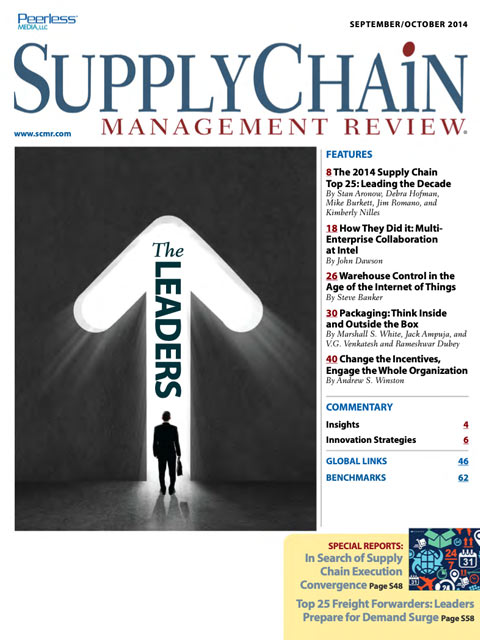Sorry, but your login has failed. Please recheck your login information and resubmit. If your subscription has expired, renew here.
September-October 2014
2014 marks the 10 year anniversary of the Gartner Supply Chain Top 25 ranking. This year we have a diverse set of large, global companies with mature, demand-driven supply chains. There are lessons to be learned from these supply chain leaders, many of whom have led their industries over the past decade. Browse this issue archive.Need Help? Contact customer service 847-559-7581 More options
Despite increasing automation, human labor remains one of the most important resources in any manufacturing operation. The hype around 3D printing and robotics may be taking up most of the airtime in manufacturing-related discussions, but there are plenty of reasons why management should start paying more attention to interactions with workers.
One reason is that since the financial crisis, unions and workers’ representatives are back in the game. The years-long trend of declining unionization rates (especially in industrialized countries) has recently slowed, with some unions even increasing membership rates and gaining more political influence as a result. In Europe, the effects of union-driven activity on German transportation systems in the past two years have been tremendous, with the cost of some strikes estimated at more than $40 million.
However, it is no longer enough to look only at developed countries. As globalization continues to play out and companies from all over the world set up operations abroad, often in low-wage countries, skilled labor has become scarce, management has become more international (and is often unfamiliar with local rules and customs), and workers’ rights are moving to the fore as labor laws are updated.
 |
This complete article is available to subscribers
only. Click on Log In Now at the top of this article for full access. Or, Start your PLUS+ subscription for instant access. |
Not ready to subscribe, but need this article?
Buy the complete article now. Only $20.00. Instant PDF Download.
Access the complete issue of Supply Chain Management Review magazine featuring
this article including every word, chart and table exactly as it appeared in the magazine.
SC
MR
Sorry, but your login has failed. Please recheck your login information and resubmit. If your subscription has expired, renew here.
September-October 2014
2014 marks the 10 year anniversary of the Gartner Supply Chain Top 25 ranking. This year we have a diverse set of large, global companies with mature, demand-driven supply chains. There are lessons to be… Browse this issue archive. Access your online digital edition. Download a PDF file of the September-October 2014 issue.
 |
Download Article PDF |
Despite increasing automation, human labor remains one of the most important resources in any manufacturing operation. The hype around 3D printing and robotics may be taking up most of the airtime in manufacturing-related discussions, but there are plenty of reasons why management should start paying more attention to interactions with workers.
One reason is that since the financial crisis, unions and workers’ representatives are back in the game. The years-long trend of declining unionization rates (especially in industrialized countries) has recently slowed, with some unions even increasing membership rates and gaining more political influence as a result. In Europe, the effects of union-driven activity on German transportation systems in the past two years have been tremendous, with the cost of some strikes estimated at more than $40 million.
However, it is no longer enough to look only at developed countries. As globalization continues to play out and companies from all over the world set up operations abroad, often in low-wage countries, skilled labor has become scarce, management has become more international (and is often unfamiliar with local rules and customs), and workers’ rights are moving to the fore as labor laws are updated.
 |
SUBSCRIBERS: Click here to download PDF of the full article. |
SC
MR

Latest Supply Chain News
Latest Podcast

 Explore
Explore
Latest Supply Chain News
- 2024 Warehouse/DC Operations Survey: Technology adoption on the rise
- Benchmarking the complexity of ESG reporting
- Looking back at NextGen 2024
- The Corporate Sustainability Due Diligence Directive
- How to make your CFO a supply chain superfan
- AI is moving omnichannel closer to the customer
- More latest news
Latest Resources

Subscribe

Supply Chain Management Review delivers the best industry content.

Editors’ Picks





